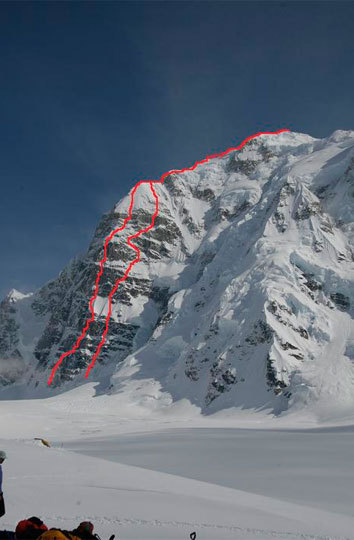
The north buttress of Mt. Hunter (14,570′) showing Moonflower Buttress (Alaska Grade 6: 5.8 A3 AI6, 6,100′, Stump-Aubrey [to last rock band], 1981; Bibler-Klewin [to summit], 1983) on the left and Deprivation (Alaska Grade 6: ED+ 90 degrees, ca. 6000’, Backes-Twight, 1994) on the right. Turgeon climbed both routes in a week in early May, likely the first time the buttress has been climbed twice in such a short period of time. [Photo] Courtesy Maxime Turgeon
Editor’s Note: Alpinist reported on Maxime Turgeon’s recent climbs in both the May 13, 2008 Newswire and May 19, 2007 Newswires. This, a detailed trip report from Turgeon, expands upon those accounts.
I was in a depressed, late-winter mood when I received an e-mail from Freddie Wilkinson. He and Ben Gilmore were going on a trip to the remote Yentna glacier in the Alaska range and they wanted me to join them for an attempt at what was probably the highest unclimbed peak in the Alaska range. I met Freddie years ago after LP [Menard] and I climbed Canadian Direct (Alaska Grade 6: M6 5.9, ca. 8000’) on the south face of Denali–since then we have been trying to get together to climb. Ben is one of those badasses that inspired me to climb in Alaska in the first place. They were going from April 19th to May 8th. Conveniently, my girlfriend Zoe Hart was going to be in Alaska for her last Ski Guide’s exam and was going to be free on May 8th. We had already made plans to climb together. I couldn’t ask for better timing.
It didn’t take much to convince me to go
On the May 21, Paul Rodrick from TAT [Talkeetna Air Taxi] landed Freddie, Ben, and I under a perfect blue sky at the base of the Yentna , right at the Wilderness Boundary of the Denali National Park. The high pressure lasted for the next three days, allowing us to set up camp and cache gear 2500′ higher–toward the base of the south face of Bat’s Ears Peak (11,044’), our objective. As soon as we returned to camp after ferrying loads, the weather crapped out—and stayed crapped out for five days. Finally, the pressure began to rise in a shy little curve.
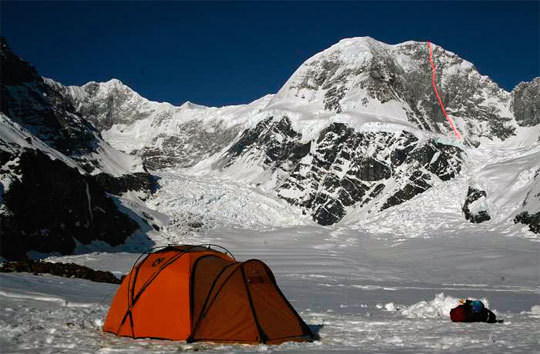
Americans Ben Gilmore and Freddie Wilkinson teamed up with Canadian Maxime Turgeon to make first ascent of the Bat’s Ears, an 11,044-foot peak that was possibly the highest unclimbed major summit in the Alaska Range. The trio climbed the nearly 3,000-foot south face of the peak in a 23-hour round trip from base camp, descending via the southwest ridge [Photo] Courtesy Maxime Turgeon
The next morning at 2:00 a.m., it was a go. We headed up for what, ultimately, was a perfect alpine climbing day. Our ascent route led up a stellar-looking linear weakness system that strikes up the face directly under the summit. The climbing went as smooth as it gets, on super-classic climbing at about AI4+ M5+. Twelve hours after crossing the shrund, we reached the summit. As we walked and downclimbed the steep west ridge, the weather began turning sour again. What a perfect sucker hole! Twenty three hours after leaving camp, we were back–from a day of almost 6000 ft of elevation gain and loss.

The summit ridge of Bat’s Ear Peak (11,044′). The team’s ascent route led up a “stellar-looking” linear weakness system that strikes up the face directly under the summit. Ultimately, the route was graded AI4+ M5+, ca. 3000′. [Photo] Courtesy Maxime Turgeon
The upper valley was totally socked-in for the next 5 days, so we convinced ourselves that the chances of doing another route on the Yentna would be a big gamble and that we would have a better chance if we were at Kahiltna to get a good day of climbing in before Freddie and Ben had to leave. At 9:00 p.m., on May 3rd–in the most improbable weather–Paul buzzed over the ridge. Our books and iPods went flying in all directions at the same time and, barely half an hour later, a big mess of all our stuff was piled full of snow dust left by Paul’s Beaver on the side of the Kahiltna air strip.
The three of us were still half asleep but our jaws fell to the ground simultaneously when we turned toward the north buttress of Mt. Hunter. It was covered with the most ice any of us had ever seen on it. That’s how the next chapter of my trip began which I would call “the perfect alpine week.”
Monday May 5, at 12:25 a.m., the alarm goes off and the stoves goes on. An aromatic blend of coffee, fried bagels, eggs, cheese and bacon conspire wake up all of our senses. It’s 4:00 a.m. when we regroup at the base of the Moonflower Buttress. We pushed it a bit breaking track and we are all sweaty. Ben pulls his socks off and a chunk of skin is hanging from his heel. Fuck!!!! A half-dollar size blister is a hard way to start a 4000′ route, but it proves to be irrelevant.
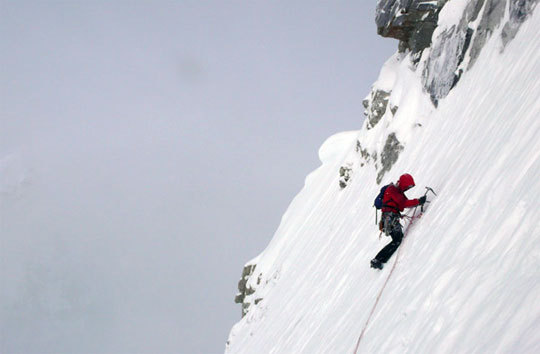
Ben Gilmore leading through the second iceband on Moonflower Buttress (Alaska Grade 6: 5.8 A3 AI6, 6,100′, Stump-Aubrey [to last rock band], 1981; Bibler-Klewin [to summit], 1983). The route features three rockbands to be surmounted, connected by discontinuous (in most years) ice runnels. Since the team was comprised of three climbers, they broke the climbing into blocks dictated by the terrain–three rockbands, three climbers. [Photo] Courtesy Maxime Turgeon
The first block is mine. Three rock bands, three climbers, easy to split. I follow Ben and Freddie’s directions as they have been on this section of the route before. Stellar ice runnels, a steep snow traverse, we are soon at the Prow. It’s like running through a history book. Freddie and Ben scream encouragement from bellow as my tools sink and lock in the thin seam of the Prow. Before I realize it I’m clipping the anchor of the pendulum. I knew that Marko Prezlj had done it free–so committed myself to the same. I keep matching front points on knobs and just before I am really going to do-in my pants, the iced side of the gully is within tool’s reach.
The pace was set and we were making good progress but the weather was deteriorating fast. By the time we reached Tamara’s Traverse, the spindrift had increased to “heavy”. When I passed the rack to Freddie, I could see in his eyes that he knew what was waiting for him in the Shaft. We shoved our cameras deep in our jackets and tightened our hoods over our helmets. Feddie disappeared under a white curtain of snow but the rope kept feeding. Every time it came to the end we joined him as fast as we could–keeping our heads down. Buy 5:00 p.m. we had made it to the top of the Shaft, and on to the second ice band. There was no way we could make it through an open bivy in those conditions. Ben didn’t seem too worry about it too much. He just took the rack and pulled us two more rope lengths leftward to a snow mushroom that had formed on a rocky ridge.
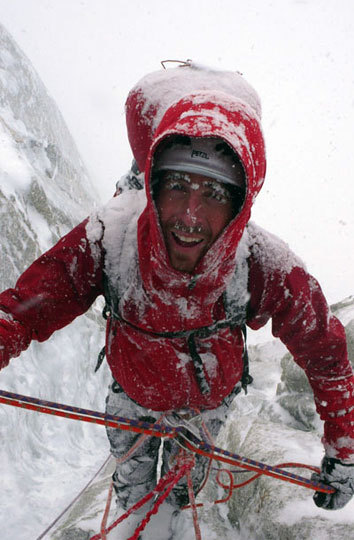
Ben Gilmore in The Shaft, one of Moonflower Buttress’ most difficult pitches. The weather began to worsen during this section of the climb, with heavy spindrift and increasing winds. [Photo] Courtesy Maxime Turgeon
An hour later we were all hanging in a six inch thick snow shell–two and a half feet wide by twelve feet long by three feet high. Aside from the fact that Ben was super-pissed at having broken part of one of the walls while digging, he created the best shelter you could have imagined.
That night, Freddie had his first experience of the two man snuggle-sack and almost didn’t want to leave it at 6:30 in the morning. He snored. A lot. At least he is a small guy. We crawled out to a bluebird day. Our perserverance the previous day had payed-off. We knew that were were going to the summit that day. Ben cruised through the Vison section, climbing it all free. I took over for the Bibbler Come Again Exit, and finally reached at the top of the buttress at 5:00 p.m.. I could barely lift my arms but Freddie was firing. Climbing as a party of three definitely has some advantages. We left every thing except our puffball jackets, one rope and two screws and he pulled us all the way up the 1700′ of elevation gain to the summit in two hours. Except for a few, all the other peaks of the range were standing below us. We could see all the routes every one of us had climbed in the range.
The sixth block of the route had come. The descent. Ben was totally up for the task and led the twenty-six rappels down the face, putting in more then twenty v-threads. By Wednesday mid-morning, we were back in basecamp.

The snowshell bivy on Moonflower Buttress. [Photo] Courtesy Maxime Turgeon
When I woke-up it was already Thursday. Trading day! Ben and Freddie were due to fly home and Zoe was waiting by the side of the runway in Talkeetna to fly to the glacier. ‘’Not that I dont like you guys, but what a good trade’’ I told them as a joke while we were waiting. We all laughed pretty hard. When Zoe stepped out of the plan here eyes were shining as brightly as the pin on her chest. She finished her last Ski Exam two days before and was now the fourth American woman to get the full UIAGM mountain guide certification. I had just completed one of the best routes of my life. We had a lot to celebrate–with the pizza and beer she had been thoughtful enough to bring with her.
The next morning we came up with a great celebratory climbing plan. Zoe had been on Deprivation two years prior, and was super-psyched to give it another try. I was simply super-excited to go back on the north buttress for a second round—conditions being so favorable.
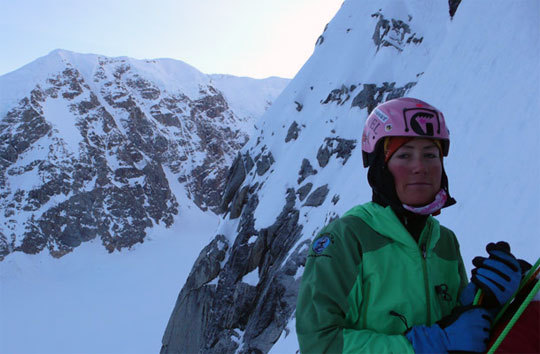
Zoe Hart, looking ecstatic low on Deprivation (Alaska Grade 6: ED+ 90 degrees, ca. 6000’, Backes-Twight, 1994). The route, when originally climbed, showed a new dedication to fast and light tactics applied in the Alaska Range. Hart is the first woman to summit Mt. Hunter (14, 570′) via the route. Kiwi Pat Deavoll summitted the north buttress via the route in 2004, but did not climb the peak to the summit. [Photo] Maxime Turgeon
Same time, same place. Sunday morning, I was again racking up at the schrund at 4:00 a.m., but this time with a nice warming kiss before heading for the pumpy dead-vertical ice wall of the schrund. I might be getting soft, but there is something nice about kissing your partner before heading for a hard pitch. Or maybe I just spend too much time spooning with other guys at bivys.
We simulclimbed through most of the lower section of the route until the Base of Death pitch. It didn’t take me long to get the origin of the name. Twenty meters from the belay with no screws in yet, on overhanging sugary ice, I was now desperately looking for pro. Unable to find anything good, I pushed a screw into the crumbly substance on either side of me, more for for Zoe and I’s mental state than anything else, then stemmed my way up–trying to focus on my balance. The rope was totally stretched when I finally found a good anchor crack.
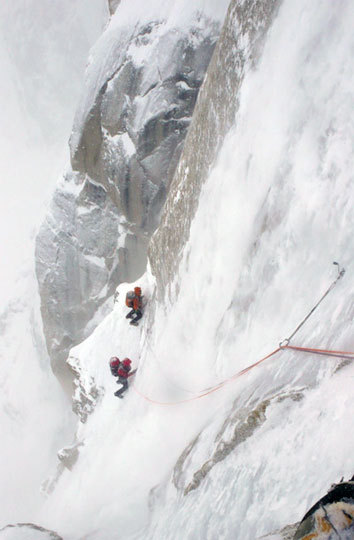
The two followers climbing through Tamara’s Traverse, Moonflower Buttress. [Photo] Courtesy Maxime Turgeon
The day was superb. We were now swapping leads as often as we could to relieve the second from the pack. Barely nine hours after crossing the schrund we were already at the base of the third ice band feeling super-good about our progress. The route does a big 300 meter traverse left and back right the same distance to the base of the final crux pitches. We sat down to brew before tackling it. In the process of rehydrating and fueling up for the labor ahead, my fingers slipped on the fabric of my DAS jacket stuff sack. As it was speeding between our legs my french roots caught up with me and a, “CHRIST DE CALISSS DE TABARNAC!!!!” slipped through my lips as the bag whipped over the seracs and disappeared into the abyss.
“Oh well, that’s a big chunk of weight right there [that] we don’t have to carry up anymore” I said to Zoe. She offered me her small puffy and we started to traverse. At the end of the traverse left, we fought the temptation of going right up to the Bibbler exit and decided to pay tribute to Mark [Twight] and Scott [Backes] by repeating their route in good style by heading back right. All that traversing ended up to be quite time consuming. It was 7:30 p.m. when we finally got to the base of the steep ice pitches. So much for our good time. The sun was now hitting the face directly and chunks of snow and ice where falling from all around. There was no way we were going to bivy anywhere around there. Up steep, hard ice it was. It took us all the energy we had left but at 11:00 p.m., in glowing light, we were standing on the top of the last rock band.
“Hey Max, what’s the name of the route again? I know it start with a D but I just cant remember it.” I thought she was kidding at first but when I tried to tell her the name I had to think a couple time about it before it came back to my mind. Deprived was definitely our state, but two hours and 300m of calf burning slopes brought us to the cornice. We had been climbing for the last twenty-one hours straight and we were both feeling sick to our stomachs.
Like an oasis in the desert, a vertical crack appeared at the end of my headlamp beam. I poked my head in it to find a perfect tunnel that was funneling deep inside a giant styrofoam-y mushroom. It felt so secure in there that–after minimal chopping–I took my harness off and we jumped into the sleeping bag.
We instantly blacked-out for two and a half hours. When we opened our eyes, a really bright ray of light was coming in from the crack. It was still nice out. To the summit I was going again. We crawled out and regrouped slowly in the sun. At noon I was stepping foot again on the top of the same snowy bump—the summit of Mount Hunter. My tracks were still visible from couple of days ago. It might seem silly to some to try to find the highest point of a snowy hill after climbing hard and technical ground, but that moment I reconfirmed that it really meant something to me and changed the meaning of the experience.
The wind picked up as we headed down the rappels on the Moonflower. Despite the cold of the spindrift pouring on me, my heart was warm. The weather allowed me to share that amazing experience with my loved one. I was the happiest man on earth. The mountain could pour anything on me now.

Hart and Turgeon on the summit of Mt. Hunter. [Photo] Maxime Turgeon